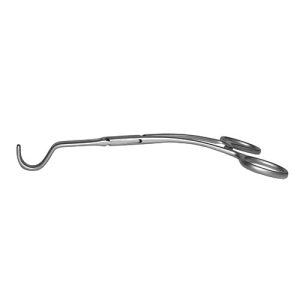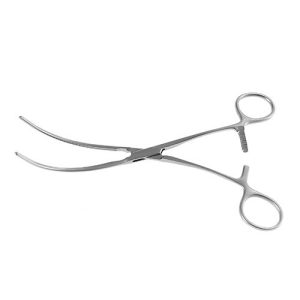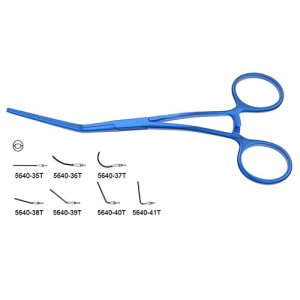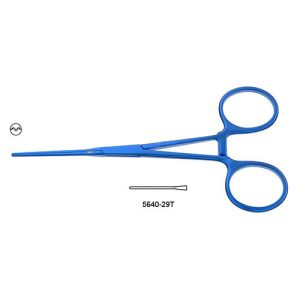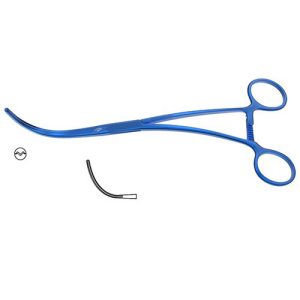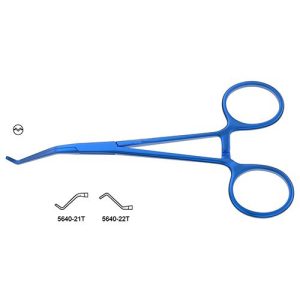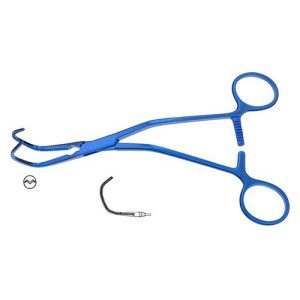Popliteal Clamp
Popliteal Clamp
Dale Femoral Popliteal Clamp is created for use in clamping of the femoral artery which later transitions to become the popliteal artery as it travels down the leg making this vascular clamp useful in cardiothoracic surgical procedures. This clamp features a hook shaped curved jaw creating a design that allows optimal clamping of the vessel while keeping the handle and remainder of the tool out of the surgical field. This instrument is available in three sizes: small, medium and large to accommodate a variety of patients and vessel sizes.
Shaped Peripheral Vascular Clamp
Shaped Peripheral Vascular Clamp
jaws 8.5 cm, 8" (20.0 cm)
DeBakey "S" Shaped Peripheral Vascular Clamp is ideally suited for use in cardiothoracic surgical procedures. The S-shape allows this instrument to fit snugly along the contour and curvature of vessels without damaging the vessel wall. This clamp can be used to reduce or stop blood flow in peripheral vessels so as to avoid excessive bleeding.
Titanium Castaneda Clamp – Angled Cooley Jaws
Titanium Castaneda Clamp - Angled Cooley Jaws
cooley jaws
Titanium Castaneda Clamp is a clamp used in a variety of cardiothoracic surgeries on newborns. The clamp is constructed of blue-anodized titanium, making it lighter weight, as well as stronger and non-magnetic. The clamp comes in a variety of lengths, shank angles, and jaw shapes, to accommodate various procedures, surgeon preferences, and patient sizes.
Titanium Castaneda Clamp – Curved Cooley Jaws
Titanium Castaneda Clamp - Curved Cooley Jaws
cooley jaws
Titanium Castaneda Clamp is a versatile tool that can be utilized in a variety of cardiothoracic surgeries on infants. The clamp is constructed of blue-anodized titanium, a metal that makes the clamp lighter weight, and thus less stressful on the surgeon's hand, as well as stronger and non-magnetic. The clamp comes in a variety of lengths and jaw curvature shapes, to accommodate various procedures, surgeon preferences, and patient sizes. It has Cooley jaw serrations that allow for non-traumatic clamping.
Titanium Castaneda Clamp – Debakey Jaws
Double-angled calibrated debakey jaws, 7-1/2" (19.0 cm), carotid clamp
Titanium Castaneda Clamp is a clamp generally used for grasping the carotid and other arteries in delicate fields during cardiovascular surgery. The clamp is made of blue-anodized titanium, a metal that is stronger and lighter than steel and also non-magnetic. It features specially calibrated DeBakey jaws designed for atraumatic occlusion of the carotid artery. The double-angled jaw configuration allows this clamp to maneuver effectively and clamp obscured arteries in the surgical field.
Titanium Debakey Micro Clamp
Titanium Debakey Micro Clamp
debakey jaws
Titanium DeBakey Micro Clamp is used most commonly for cardiothoracic surgeries to clamp smaller vessels. The clamp's titanium composition makes it both lighter and stronger than the competition, reducing hand strain, as well as making it non-magnetic. The jaws are serrated with DeBakey teeth for gentle yet effective clamping. The clamp comes in a wide variety of small jaws sizes and angle configurations to match different surgeon and procedure needs.
Titanium Debakey Micro Clamp – Angled Jaws
Titanium Debakey Micro Clamp - Angled Jaws
angled debakey jaws.
Titanium DeBakey Micro Clamp is most often used for cardiovascular surgeries to clamp smaller vessels. The clamp's titanium composition makes it extremely lightweight and strong, so as to reduce strain on the surgeon's hand, in addition to making it non-magnetic. Numerous jaw angle and instrument lengths are offered to accommodate various procedures, and all versions feature DeBakey serrated jaws for atraumatic clamping.
Titanium Debakey Micro Clamp – Straight Jaws
Titanium Debakey Micro Clamp - Straight Jaws
straight debakey jaws
Titanium DeBakey Micro Clamp is generally used for cardiothoracic surgeries to clamp smaller vessels. The clamp's titanium composition makes it both lighter and stronger than the competition, so as to reduce hand strain, as well as making it non-magnetic. Its small jaw length gives it the control and precision needed to clamp small vessels, and the straight DeBakey jaws ensure atraumatic occlusion.
Titanium Debakey Vascular Clamp
Titanium Debakey Vascular Clamp
debakey jaws, 7.5 cm jaws, 7-3/8" (18.8 cm)
Titanium DeBakey Vascular Clamp is most commonly used in cardiothoracic operations involving larger vessels or the heart. Because it is made from blue-anodized titanium, the clamp is lighter, stronger, and not magnetic, making it the ideal choice in any operating room. Its increased jaw length allows it to reach and clamp vessels deep in the surgical field, while the DeBakey jaw serrations allow for atraumatic occlusion.
Titanium Kay Aorta Clamp
Titanium Kay Aorta Clamp
debakey jaws, 3.0 cm jaws, 8" (20.0 cm)
Titanium Kay Aorta Clamp is designed to gently clasp larger vessels in cardiothoracic procedures where surgical anastomosis is needed. The clamp's titanium composition makes it lighter and stronger, as well as non-magnetic, reducing strain on the surgeon. The DeBakey serrated jaws allow for clamping that does not result in trauma.
Titanium Kitzmiller Micro Clamp
Titanium Kitzmiller Micro Clamp
angled debakey jaws, 23.0 mm jaw length, 4-1/4" (11.0 cm)
Titanium Kitzmiller Micro Clamp is designed for use in a variety of cardiothoracic surgeries where small vessels must be occluded. Because it's made of blue-anodized titanium, the clamp is very light, reducing strain on the surgeon without sacrificing strength. It also is non-magnetic, meaning less hassle in the operating room. The jaw configuration features DeBakey serrations for atraumatic occlusion, and both left and right angled options.
Titanium Lambert-Kay Aorta Clamp
Titanium Lambert-Kay Aorta Clamp
debakey jaws, 3.0 cm jaws, 8" (20.0 cm)
Titanium Lambert-Kay Aorta Clamp is generally implemented in cardiothoracic anamostosis procedures involving larger vessels. It is made of titanium, making it extremely strong, exceptionally light, and non-magnetic, which eliminates hassle in the operating room. The clamp is made with DeBakey jaws, which allow for powerful, efficient clamping without causing damage to vessels.

